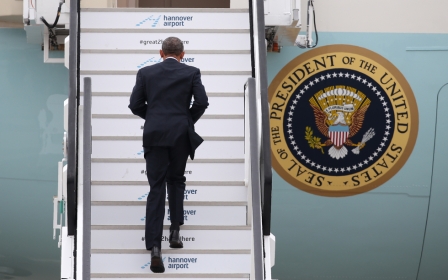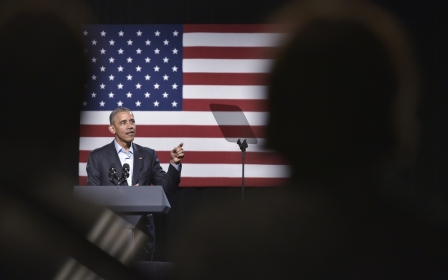The Syria 'dissent' memo and US bureaucratic support for Kerry war strategy

The memorandum by 51 State Department officials calling for US military intervention in Syria last week has been treated in news media coverage as a case of dissent from existing Syria policy by individual officials involved in Syria policy.
But the memo has all the earmarks of an initiative that had the blessing of the most senior officials in the department – including Secretary of State John Kerry himself - rather than having been put together by individual officials entirely on their own. And it may mark the beginning of an effort to take advantage of the presidential candidacy of Hillary Clinton.
The memo called for a “more militarily assertive US role” in the Syrian conflict in the form of “a judicious use of stand-off and air weapons, which would undergird and drive a more focused and hard-nosed US-led diplomatic process". That is precisely the policy option that Secretary of State John Kerry has been widely reported to have championed privately for years. As the story in the New York Times, which published the supposedly confidential memo, noted, “[H]igher-level State Department officials are known to share their concerns.”
The submission of the memo through the State Department’s “dissent channel” appears to have been a device to make it appear entirely independent of senior officials in the department. According to the State Department regulation on the “dissent channel,” it is to be used only when dissenting views “cannot be communicated in a full and timely manner through regular operating channels or procedures” or “in a manner which protects the author from any penalty, reprisal, or recrimination.”
But there is no reason to believe that the officials in question had any problem in expressing their views on Obama’s Syria policy over the years. The names of the signatories were not included in the document published by the New York Times, but all 51 officials claimed to have been directly involved in the making or implementation of Syria policy, according to the report. That would certainly encompass the vast majority of those who have worked on Syria over the past five years. It is inconceivable that those officials have not participated in innumerable policy discussions on Syria in which their personal views were freely expressed.
The Kerry line
The supposed dissenters knew very well, moreover, that Kerry has been advocating the essentially the same policy they were articulating for years. Kerry began making the case for sending large-scale, heavy weapons to armed opposition groups and carrying out cruise missile strikes against the Assad regime’s air force in 2013. He continued to advocate that military option in meetings with the president, only to be rebuffed, according to the account by The Atlantic’s Jeffrey Goldberg published in April. Obama became so irritated by Kerry’s recommendations for cruise missile strikes in Syria that he decreed that only the secretary of defence would be permitted to recommend the use of force.
Since mid-2013, Kerry has been the leading figure in a political-bureaucratic coalition favouring a more aggressive military and covert action role in Syria. The coalition also includes the CIA’s National Clandestine Services and civilian leaders in the Pentagon who are loath to see the United States cooperating with Russia and relying on its military power in Syria.
The arguments made by the purported dissenters are in line with some of Kerry’s public talking points. Although he has not call for US attacks on Assad’s forces explicitly, Kerry has strongly hinted that there is little or no hope for progress in the political talks on Syria without some US leverage on Assad. The memo sounds the same theme: “While the regime maintains the advantage,” the authors aver, “an undeterred [Assad] will resist compromises sought by almost all opposition factions and regional actors.”
Kerry frequently reiterates in public statements that the Islamic State (IS) cannot be defeated as long as long as Assad remains in power. The memo echoes his argument, asserting: “The prospects for rolling back Daesh’s hold on territory are bleak without the Sunni Arabs, who the regime continues to bomb and starve.”
The Nusra question
The memo presents missile strikes as a way of responding to Assad’s “egregious violations of the ceasefire”. The idea that Assad is responsible for the breakdown of the ceasefire, which ignores the well-documented fact that many of the groups that Kerry calls the “legitimate opposition” openly sided with al-Nusra Front in deliberately and massively breaking the ceasefire, is also part of the Kerry State Department public posture. The memo never even mentions the problem of al-Nusra Front and the risk that the use of US force to change the military balance between the opposition and the regime would risk an ultimate victory by the jihadists.
One point in memo sounds very much like an argument intended to be leaked to the media in order to dramatise the case for war against the Assad regime. “None of us see or has seen merit in a large-scale US invasion of Syria or the sudden collapse of existing Syrian institutions,” it says. Since no one in the administration is advocating a “large-scale US invasion” or the “sudden collapse” of the Syrian state, that sentence was clearly calculated to influence public opinion rather than to convince anyone in the State Department of the need for the use of force.
Kerry made no effort to hide his pleasure with the “Dissent Memo”, telling a reporter on 20 June that the memo was “good” and that he intended to meet with its authors. His spokesman John Kirby said he would not characterise Kerry’s comments as “indicative of a full-throated endorsement of his views” in the memo – an obvious hint that it was consistent with Kerry’s views.
Kirby went on to say that State Department is “discussing other alternatives, other options, mindful...that the current approach is, without question, struggling.” After Kerry’s meeting with 10 members of the group on 21 June, Kirby refused to say whether Kerry agreed with the signatories, citing the need “to respect the confidentiality” of the “dissent channel” process.
Clinton group backs memo
The leak of the memo coincided with the advocacy of the same military option by a Washington think tank with ties to Hillary Clinton. On 16 June, the very day the New York Times published the story of the leaked memo by State Department officials, the Center for New American Security (CNAS) released a report on a study group on defeating the Islamic State that called for a US policy to “threaten and execute limited strikes against the Assad regime”, to signal to Assad as well Russia and Iran that it is “willing to get more engaged”. The same report called for dispatching “several thousand” US troops to Syria.
The study group was co-chaired by CNAS co-founder Michele Flournoy, formerly third-ranked Defense Department official, although the report was written by lower-level CNAS staff members. Since leaving the Obama administration in 2009, Flournoy has been critical of its defence policy and is now regarded as the most likely choice for defence secretary in a Hillary Clinton administration.
Clinton is clearly sympathetic to the military option the leaked memo. The timing of the appearance of both documents immediately after Clinton had clinched the nomination suggests that the bureaucratic figures behind the push for a new war in Syria are seeking to take advantage of the Clinton presidential run to build public support for that option.
- Gareth Porter is an independent investigative journalist and winner of the 2012 Gellhorn Prize for journalism. He is the author of the newly published Manufactured Crisis: The Untold Story of the Iran Nuclear Scare.
The views expressed in this article belong to the author and do not necessarily reflect the editorial policy of Middle East Eye.
Photo: US Secretary of State John Kerry attends an Iftar reception to mark World Refugee Day at the All Dulles Area Muslim Society (ADAMS) in Washington on 20 June, 2016 (AA).
This article is available in French on Middle East Eye French edition.
Middle East Eye propose une couverture et une analyse indépendantes et incomparables du Moyen-Orient, de l’Afrique du Nord et d’autres régions du monde. Pour en savoir plus sur la reprise de ce contenu et les frais qui s’appliquent, veuillez remplir ce formulaire [en anglais]. Pour en savoir plus sur MEE, cliquez ici [en anglais].





